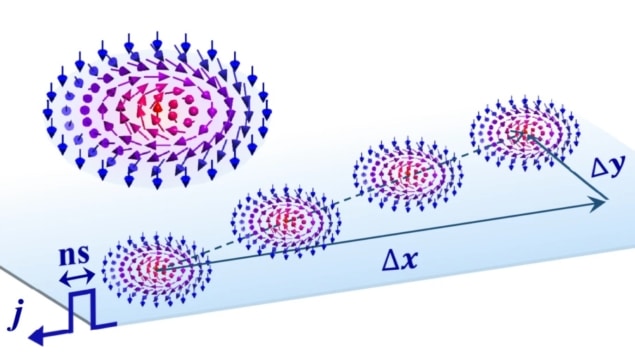 Xiuzhen Yu, together with colleagues at Japan’s RIKEN Centre for Emergent Matter Science, formed the skyrmions in chiral-lattice magnets, then steered their paths using ultra-short electrical pulses. The team hopes that their results could pave the way for advanced, skyrmion-based information storage devices.
Xiuzhen Yu, together with colleagues at Japan’s RIKEN Centre for Emergent Matter Science, formed the skyrmions in chiral-lattice magnets, then steered their paths using ultra-short electrical pulses. The team hopes that their results could pave the way for advanced, skyrmion-based information storage devices.
In condensed matter physics, skyrmions are particle-like excitations in magnetic materials that resemble vortices. They have topological stability, which means that they persist for very long times and are resilient to external perturbations such as noise. This stability means that skyrmions could be used in spintronics, which is an emerging technology in which magnetic spin is used to store and transfer information using much less energy than existing electronic devices.
So far, the motion of skyrmions have been observed in clusters or with large skyrmions (1 micron or bigger) in materials chilled to very low temperatures. However, to create practical spintronics devices, researchers must be able to manipulate the motions of small, individual skyrmions, in room-temperature conditions.
Chiral-lattice magnet
To achieve this, Yu’s team generated skyrmions within an alloy of cobalt, zinc and manganese that is a chiral-lattice magnet. This has a crystal structure that cannot be superimposed on its mirror image. In principle, skyrmions could be stable at room temperature in such a material.
Using nanosecond current pulses, the researchers could then force individual skyrmions to move in specific directions. To track these motions, the team used transmission electron microscopy (TEM), relying on the fact that skyrmions interact with an electron beam. Specifically, they used a form of the technique named Lorentz TEM, which is a powerful tool for studying topological magnetic structures.
Topological number
Through these observations, Yu and colleagues discovered that the motions of single skyrmions (each about 100 nm in size) were clearly affected by their topology. When a skyrmion’s topological number was reversed, the team spotted a subsequent reversal in its Hall motion – generated as the pulsed current flowed both perpendicular both to an applied magnetic field, and transverse to the voltage across the chiral-lattice magnet conductor.

Talking skyrmions in Columbus, Ohio
They also showed that when current pulses were applied, the skyrmion transitioned from a static “pinned” state – induced by defects in the lattice, to a linear flow motion exceeding 3 m/s. This occurred via a “creep event” – where the skyrmion’s velocity gradually increased, after exceeding a certain threshold value.
The experiment was the first time that researchers have tracked and controlled the motion of a single skyrmion. Yu’s team now hope that further studies of these dynamics, and their dependence on skyrmion topology, could lead to the use of skyrmions in spintronics devices.
The research is described in Nature Communications.
